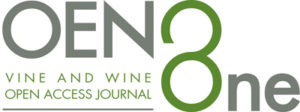
Recent advancements in understanding the terroir effect on aromas in grapes and wines
Abstract

OENO One – Special issue
Terroir is about the link between wine and its origin. It has long been understood by sensory evaluation that the taste of wine from a given variety can be related to its origins. Specific organoleptic characteristics of wine are influenced by environmental factors such as soil and climate. By deconstructing the effect of measurable soil and climate parameters on grape and wine aroma compounds, the terroir effect on wine typicity can be better understood. Climate influences on vine development and grape ripening are mainly associated with temperature, radiation and rainfall, while soil influences are primarily associated with water availability and nitrogen supply. Significant advances have been made over recent years in understanding wine aromas and their molecular basis and influences of climate and soil on a wide range of molecules responsible for wine aroma expression. This article aims to review these recent research advances to obtain a more comprehensive understanding of how terroir influences wine typicity. The effect of terroir on wine quality and typicity is sometimes considered intangible and difficult to explain on a scientific basis. By combining agronomic, analytical and sensory approaches, however, this review shows that the terroir effect is mediated by measurable factors that can easily be monitored in the vineyard. Assessment of the results compiled by this review allows the suggestion that terroir expression at specific sites might be maximized by choosing appropriate plant material in relation to soil and climate, by acting on manageable parameters like vine water and nitrogen status, or by implementing canopy management to modify microclimate in the bunch zone.
DOI:
Issue: Terroir 2020
Type: Video
Authors
1EGFV, Université de Bordeaux, Bordeaux Sciences Agro, Inrae, ISVV, 33882 Villenave d’Ornon, France
2Unité de Recherche OEnologie, EA 4577, USC 1366 INRA, ISVV, Université de Bordeaux, 33882 Villenave d’Ornon France
3PPGV, Université de Toulouse, INP-PURPAN, 75 voie du TOEC, F-31076 Toulouse Cedex 3, France
4Texas A&M AgriLife Extension Service, TAMU, Lubbock 79403, Texas, United States
5Demptos Research Center, CESAMO, Institut des Sciences Moléculaires, Univ. Bordeaux, 351 Cours de la Libération, F-33405 Talence, France
6Tonnellerie Seguin-Moreau, ZI Merpins, 16103 Cognac
7Hochschule Geisenheim Unversity, Von-Lade-Strasse 1, 65366 Geisenheim, Germany
Contact the author
Keywords
Terroir soil climate temperature radiation water balance nitrogenvine wine aroma typicity
